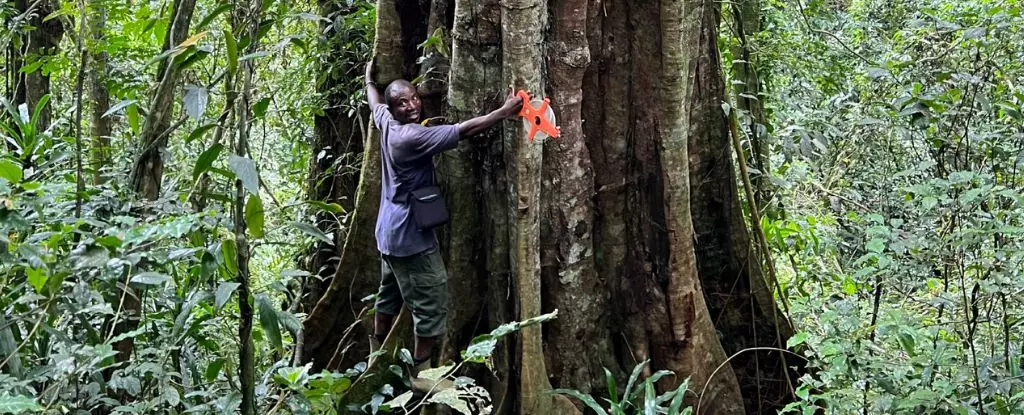The heart of Tanzania hides a botanical marvel that defies time and conventional understanding of biodiversity. Nestled in the misty expanse of the Udzungwa Mountains, a species of tree, now known as *Tessmannia princeps*, has recently been unveiled to the scientific community. Standing towering at 40 meters (approximately 130 feet), this magnificent entity was discovered during a botanical survey in 2019, revealing that nature still harbors secrets, even among the giants. What makes this discovery truly astonishing is not merely the height of this tree but the potential lifespan that scientists speculate it could reach—up to 3,000 years.
Such details evoke a sense of wonder and urgency, especially considering the grim reality threatening this ancient species and its environment. The initial encounter with *T. princeps* by botanist Andrea Bianchi and local experts was a moment of serendipity, sparking curiosity and determination to understand this unique specimen. Its distinct grayish bark, towering root buttresses, and fragrant blooms offer a glimpse into how evolution has crafted resilience in a fiercely competitive ecosystem.
The Ecological Significance of Old-Growth Trees
Beyond the aesthetic and wonder of *T. princeps*, its ecological role cannot be overstated. Old-growth trees are foundational pillars of their ecosystems, providing essential services such as carbon sequestration, habitat for myriad species, and a stabilizing influence on soil and water cycles. However, the sobering statistics reveal a stark reality: the world is losing these incredibly important ecosystems at an alarming rate. The report indicates that we lost nearly 4 million hectares of old-growth rainforest in just one year—an area akin to Belgium—a vivid reminder of what we risk if we fail to act.
As the scientific community shifts focus to climate change and conservation, the rising sentiment is that of urgency. *Tessmannia princeps* is not merely a newly identified species; it symbolizes a critical touchstone in our understanding of how biodiversity can inform both ecological restoration and climate action. Recognizing its vulnerability is the first step toward ensuring that such species do not fade into obscurity, yet the document also suggests a troubling trajectory where continued habitat loss seems inevitable without concentrated conservation efforts.
The Dichotomy of Hope and Despair
What’s particularly striking about the narrative surrounding *T. princeps* is the paradox of discovery amidst impending doom. While the identification of this species paints a picture of hope regarding the resilience of life, it also serves as a cautionary tale about human impact on natural habitats. Extending only to about 1,000 remaining individuals, these trees are emblematic of an excessive greed-driven depletion of our natural surroundings. As scientists highlight the history of deforestation over the last century—an alarming transformation of the habitat where these trees exist—it raises existential questions about what future generations will inherit.
The significance of the “ecosystem bridge” they form with neighboring forests cannot be overstated. It is a reminder of interconnectedness, where the survival of one species may hinge on the health of an entire ecological network. Herein lies the challenge: balancing development, conservation, and the aspirations of 5,500 villagers who rely on these ecosystems. Absent thoughtful urgent action to protect these ancient giants, the outlook appears dire, with estimates suggesting that 75 percent of undiscovered plant species, akin to *T. princeps*, are at risk of extinction.
Conservation: A Moral Imperative
As stewards of the planet, the onus is on us to recognize the value embedded within these ancient trees. Policies that prioritize ecological health not only sustain *T. princeps* but ultimately safeguard our own future. This should resonate with a liberal ethos that champions inclusion, sustainability, and the recognition of nature’s intrinsic value—a necessary shift in perspective. True progress lies in embracing bold initiatives dedicated to restoration, enforced protection against unchecked development, and fostering education to instill a sense of duty toward these living antiquities.
The narrative of *Tessmannia princeps* is not just an academic discovery; it is a rallying cry for conscious stewardship, urging society to confront its ambitions with tempered wisdom and responsibility. As we stand on the cusp of ecological collapse, the majestic tree serves as a poignant reminder of what is at stake in our shared environment. This venerable species is a testament to resilience and endurance, but it needs humanity’s commitment to remain a living testament for the ages.


Leave a Reply